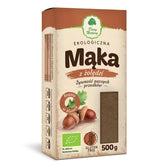Mustard varieties, their composition and health-promoting properties – not just a popular spice
CONTENTS:
- What is mustard actually?
- What should you pay particular attention to when buying mustard?
- Mustard varieties and their properties
- The nutrient content in mustard
- Health-promoting properties of mustard
- Contraindications to the use of mustard
- Summary
Mustard is one of the most popular condiments in the world. Suffice it to say that many countries and cultures have their own distinct and unique versions, clearly associated with a particular country. This is not without reason. Mustard is one of the healthiest cold sauces. Not only does it add variety to many dishes, but it can also pleasantly surprise us with its health-promoting properties. The ancient Romans used it to treat rheumatism and digestive disorders, among other things. How can we still use it, and why is it so healthy? We invite you to read on.
What is mustard actually?
Mustard is a plant from the Brassica family. The seeds of some of its varieties are used to make mustard. The most common mustard varieties are white, brown, and black. Individual seeds of these plants differ in both flavor and nutrient content. Therefore, the type and other parameters of the finished mustard largely depend on the type of mustard used. Interestingly, mustard was known in ancient times among the Sumerians, Greeks, and Romans. The production process itself differed little from today's. Except for technological issues, of course. However, it is believed that about 1,000 mustard seeds should be used to make 200 grams of mustard. Keep in mind, however, that this is not the only ingredient of this condiment. The basic components also include vinegar (spirit, wine, apple), oils, water, pepper, sugar, salt, and other spices. These ingredients form the basis of the sauce, although their proportions may vary depending on the type of mustard. Common additions can also include honey, horseradish, maple syrup, or fruit. Recently, mustard with added cranberries, prunes, and even whiskey has become very popular. However, turmeric and riboflavin, or vitamin B2, are also used to enhance the color and add additional flavor.
What should you pay particular attention to when buying mustard?
Mustard itself is a nutritionally valuable and generally healthy product. However, it's worth checking whether it contains too many preservatives and additives to enhance the flavor. Sulfites, which are hidden under the symbols E220 and E227, can be particularly harmful to health. They are intended to extend the shelf life of the finished product. Various thickeners and colorings are also common. Tetrazine, also known as E102, is popular. It has a negative effect on our bodies, and we should avoid mustard that contains it. Interestingly, the use of such additives is not recommended for another reason. Mustard is naturally well preserved. Such effects are exhibited by, among others, mustard and vinegar. Therefore, the use of non-natural preservatives is not particularly justified. Interestingly, mustard made only with these natural ingredients can be stored for up to 6 months even after opening. You should keep it in the refrigerator, but the result is still impressive. When choosing mustard, you can also consider the mustard content and the quality of the seeds themselves. However, it's no surprise that the health benefits of this product increase with the quantity and quality.
Mustard varieties and their properties
There are a whole galaxy of different mustard varieties and their different types and variations. It's impossible to list and describe them all. However, we'll focus on the most popular and those that are certainly easy to find on store shelves.
- Deli mustard – undoubtedly the most popular mustard, characterized by a creamy consistency and a delicate flavor and aroma. A perfect complement to meat, sausages, and sandwiches.
- French mustard – the only mustard variety that contains whole, unground mustard seeds. It's quite spicy, with a slightly vinegary aftertaste and aroma. Perfect for roasting and baking.
- Russian mustard – one of the spicier varieties of this spice. It is dominated by coarsely ground black mustard seeds. It can be served with almost any dish, but pairs particularly well with meat—especially roasted, stewed, and fried.
- Dijon mustard – highly prized by chefs. Its flavor and aroma are quite dry. Its distinctive feature is the use of white wine instead of vinegar, making it highly distinctive and typical of French cuisine. It is often added to sauces, dressings, or roasts.
- Sarepska mustard – slightly spicier and more expressive in flavor than deli mustard. It is made from brown and white mustard. It is one of the basic varieties of this spice and therefore very versatile.
- Kremska mustard – one of the sweetest mustard varieties. Its characteristic features are a sweet taste and aroma, as well as very finely ground mustard seeds. This results in a very creamy and compact consistency. It is ideal as an accompaniment to salads, meat, and cheese.
- Horseradish mustard – a classic mustard with grated horseradish added. It is characterized by a unique, slightly burning flavor and aroma. It is most often added to meat dishes, but also to eggs and white sausage.
- English mustard – both white and black mustard seeds are used in its production. Its characteristic feature is the addition of turmeric. It has a pungent taste and aroma. Nevertheless, it is very versatile and is added to many dishes, especially in the British Isles.
- Bavarian Mustard – This mustard combines white and black mustard seeds. They are fairly coarsely ground and owe their very sweet flavor to a large amount of honey. Very popular in Germany, especially in Bavaria. It pairs perfectly with grilled meats and sausages.
- Table mustard – one of the most popular mustard varieties. It is characterized by a slightly spicy flavor and a balance between sweetness and dryness. It is highly versatile and suitable for almost any occasion, as an accompaniment to salads, meat dishes, sauces, or cold cuts.
Of course, there are many other varieties of this popular spice. Worth mentioning are mustards with fruit, various alcoholic beverages, and other additives such as onion, pepper, tarragon, or cumin. There are also mustard varieties for specific groups, including those with celiac disease. There are also mustard varieties for children, as well as those with reduced salt content and vegan mustards. The selection is truly impressive.
The nutrient content in mustard
Since there are many types of mustard, we'll focus on the basic version. 100 grams of this popular condiment contains about 66 kcal, of which a small spoonful provides about 5 kcal. It's one of the lower-calorie sauces. Mustard can be a good source of macro- and micronutrients, as it contains 4.4 grams of protein, 5 grams of carbohydrates, and 4 grams of fat. It also contains vitamins C and A, as well as valuable vitamin B6. It's also a good source of sodium, potassium, calcium, iron, and magnesium.
Health-promoting properties of mustard
Since mustard consists largely of mustard seeds, it has a similar effect on our bodies. It can positively affect the bacterial flora in our gut, support digestive processes, and even bowel movements. Mustard seeds swell in the intestines, thinning stools. They can also have a positive effect on the condition of our blood vessels by reducing excessive calcification, but they also act as a natural remedy that lowers blood pressure—white mustard, in particular, has these properties. Thanks to its low calorie content, mild laxative effect, and metabolism-boosting properties, mustard is an excellent choice for people looking to lose weight. Despite its low calorie content, it is also an excellent substitute for mayonnaise and other sauces that contain a high energy load in small amounts. Mustard can also help combat skin blemishes, as well as liver and pancreatic diseases. It's worth mentioning that, thanks to its anti-inflammatory properties, it can be a specific remedy for rheumatism and various forms of arthritis. For this purpose, compresses containing this spice are recommended. Furthermore, the essential oils it contains can be used as a complementary medication for colds and flu, thanks to their antibacterial properties and nasal relief.
Contraindications to the use of mustard
Mustard is not only a very healthy product but also very safe. However, keep in mind that there are many varieties of it. Therefore, people who are allergic to mustard, as well as other mustard ingredients, should be careful. The enormous amount of various additives means that we should read product labels carefully to see if it contains an ingredient to which we are allergic. Furthermore, it should not be consumed by children under 4 years of age. However, it is worth remembering that in exceptional cases, its consumption is even recommended due to its positive effects on our body and its high nutrient content.
Summary
Mustard is truly one of the healthiest cold sauces. Interestingly, there are virtually no contraindications to its use, and it can bring us far more benefit than harm. It's worth considering using it as a substitute for other, less healthy sauces. Its versatility also benefits it. Thanks to the variety of varieties and thus flavors and aromas, everyone will find something to their liking. It's not only a well-known and appreciated condiment, but also a product with high nutritional and health-promoting value.
THE PUBLISHER'S CHOICE
Dried plums 1 kg BIOGO
- €7,01
- €7,01
- Unit price
- / per
Dried White Mulberries 500 g ORGANIC
- €5,84
- €5,84
- Unit price
- / per
Almonds 1 kg BIOGO
- €11,69
- €11,69
- Unit price
- / per
Cranberries sweetened with apple juice organic 1 kg BIOGO
- €16,37
- €16,37
- Unit price
- / per
Dried dates 1 kg BIOGO
- €4,21
- €4,21
- Unit price
- / per
Unpeeled buckwheat groats 1 kg BIOGO
- €2,81
- €2,81
- Unit price
- / per
Walnuts 800 g BIOGO
- €8,65
- €8,65
- Unit price
- / per
Peeled sunflower seeds 1 kg BIOGO
- €3,04
- €3,04
- Unit price
- / per
PULLED ORGANIC SUNFLOWER SEEDS 1 KG BIOGO
- €4,44
- €4,44
- Unit price
- / per












































































































































